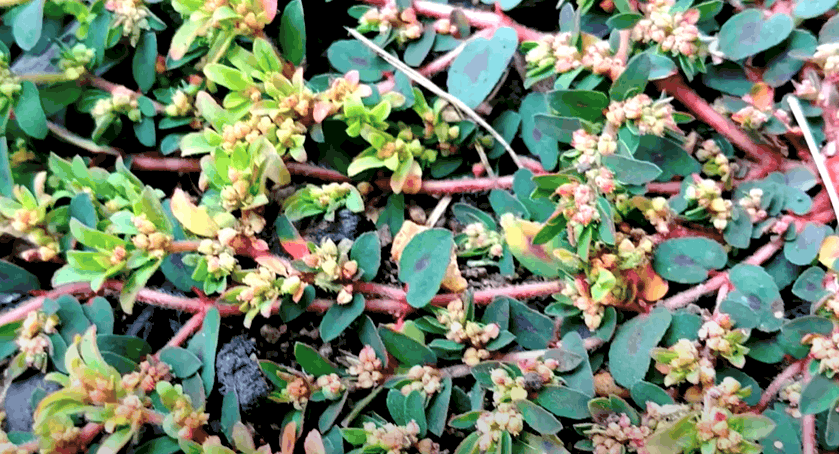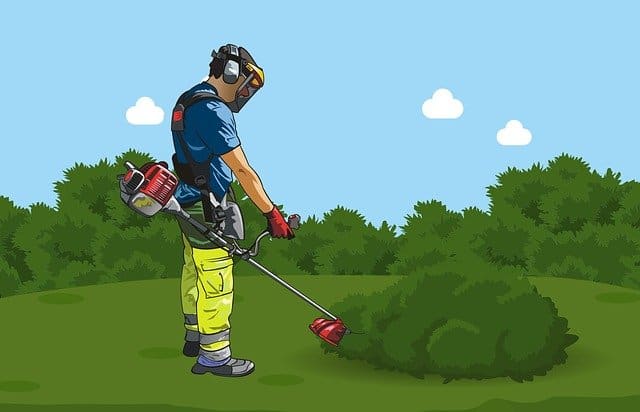Not all spurges are invasive. Two types of spurges mainly affect your garden/lawn. Spotted spurge and Garden Spurge.
These spurges are so good at thriving as they release seeds multiple times in a season. Although it’s annual and it dies off in winter, its progeny successfully takeover!
Getting rid of spurge in flower beds is quite easy if you know some basic facts about spurge.
You must first learn to identify spotted spurge. Its leaves are smaller than that of garden spurge’s and the leaves have a red spot in them.

As you can see in the image, they have a red or purple dot in the middle. The flowers are white and the plant spreads horizontally.
What factors favor the growth of Spurge in your garden?
Spurge seeds that are produced by predecessors rest in the soil and they germinate when the soil temperature is around 75°F.
Although 75°F is the ideal temperature, they can even germinate at temperatures ranging from 60°F to 100°F just fine.
Such conditions usually are seen in March(In Florida). You can google to find out when such soil temperatures are seen in your area.
Spurge is primarily seen near pavement edges (or in between the pavement stones) as the temperature here is usually suitable for its growth.
What kills spurge weed?
Let’s talk about eradicating those nasty spurges for good!
The most economical way is to pull the weed out with your hands. The spurge sap is proven to be an eye and skin irritant, so be sure to wear a pair of garden gloves when you do this.
This best works when the spurge is not widely spread. What to do when it is thriving in your beautiful garden?
You use other means to get rid of it.
Does vinegar kill spurge?
Yes, white vinegar can kill spurge if used well. It is often used to eradicate other common weeds like Crabgrass.
Here’s how to prepare a solution that can kill spurge.
Ingredients:
- Distilled White Vinegar
- Dish Soap
Take 500 ml (approx.) of white vinegar in a plastic bottle (empty soft drink bottle) and add some dish soap to the bottle and mix it well.

Now make a hole into that bottle cap and you can unleash your fury onto those nasty spurges!
Make sure the spurge is covered well in the vinegar mixture. Avoid spilling/spraying this mixture on flower beds/garden plants as this is not a selective herbicide and will harm the ornamental plants.
You can avoid this by placing some kind of screen/cardboard to cover your garden plants. It is a cheap but good way to eliminate spurge.
But it has its drawbacks.
Drawbacks of using vinegar:
- This mixture is best used on a sunny day and it also works best on spurge that is well exposed to the sun. This mixture works only if the temperature is above 85°F.
- If rain is due the next day(according to forecasts), it’s better not to spray as it might spread to nearby flower beds.
- The area where you applied should not come in contact with water, if it does the spurge comes back in two weeks!
Flower beds are watered regularly using sprinklers, water cans, or soaker hoses and that will help thrive spurges too.
This means you may have to spray this vinegar mixture every two weeks if you want to see a garden clear of spurge. Of course, it’s hard to do this regularly.
Don’t worry now my fellow gardener! Let’s talk about other ways to get rid of spurges.
Using Herbicide for Spurges
Let’s see how to use a herbicide preemptively.
An ideal herbicide is both pre-emergent and eradicative. The mixture we would be using will not only eradicate the existing spurge but also prevent fresh spurge growth.
Before making the herbicide make sure you have a precise spraying machine that can focus just on the spurge and not sprays all over the place.
Does Roundup kill spotted spurge?
Yes, Roundup(Glyphosate) can successfully kill spotted spurge. Take Roundup solution or some other weed killer with 41% Glyphosate and some Dithiopyr liquid. Now mix 0.7 oz Dithiopyr in a gallon of Glyphosate.
The Glyphosate kills the grown weeds and the dithiopyr prevents any future growth of spurge as it acts as a pre-emergence herbicide.
Spot spray!
When spraying this mixture use a focused spray and keep its nozzle as close to the spurge as possible so you don’t spray even a lil’ mixture onto your ornamentals.
Check for the weather forecast before you spray this mixture on those spurges and make sure there is no rain for the next 24 hours.

You don’t want this mixture spreading around anywhere near your ornamentals. Shield your ornamentals with some cardboard if possible.
This mixture is most commonly used in lawns and turf, but it works great on flower bed spurges too, you just need to be careful and spot spray.
Also do not pluck out the spurge before treating it with herbicide. It dies sooner if there is more foliage on the ground as it absorbs more of the herbicide.
Pre-emergence herbicide spray
The best time to spray this on spurge is before the time of their germination. At my place, I should be spraying it in the month of March for the best results.
The seeds that are already in the soil fail to germinate as the soil is full of herbicide.
Spurge Prevention
Yes, you can prevent spurge from ruining your awesome garden if you take some precautions.
Spurge seeds germinate when they get enough sunlight. This is something you can control.
Hide the sun!
Many gardeners use landscape fabric to achieve this. A good landscape fabric may work well for over a year. It will serve the purpose and stop the sunlight from reaching the soil.
You can also use a 3-inch layer of mulch and pine straw to cover the surface of the soil. This works well but you might want to change it every month as if it decomposes, you’ll again see spurge growth on the mulch itself!
You can also use decorative rocks to make a layer that covers the soil well and doesn’t let sunlight into the soil.
You might want to use cardboard to cover the flower bed soil instead of landscape fabric, it’s economical and helps recycle cardboards.
You can also use selective herbicides with TREFLAN to successfully prevent spurge growth in flower beds as it does not affect ornamentals much.
This is one such herbicide that has 70% extract of neem oil and is proven to get rid of spurge from flower beds. This herbicide is pet-safe too, making it even more desirable to pet owners like me.
I used it in my flower beds and I must say this is the best way to eliminate those nasty spurges.
Wrappin’ it up
My best advice to you is to take good care of your flower beds and check for any weedlings monthly or fortnightly if possible.
If you see any weedling just pluck it out with its roots. Wear gloves while you do this. Doing this regularly will prove quite helpful in preventing an extensive spurge outbreak.
Using a drip irrigation system can also prevent weed growth.
Thank you for stayin’ with me through this long post! I wish you awesome spurge-free gardening!

